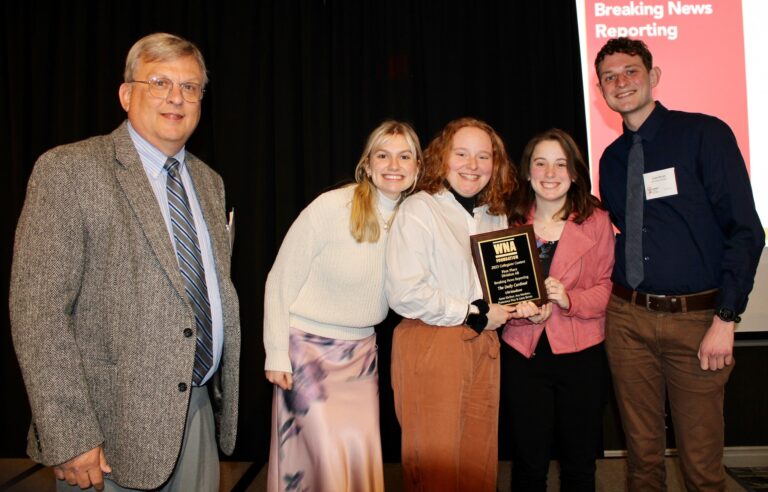The following remarks were made by Andrew Johnson, publisher of the (Mayville) Dodge County Pionier, Campbellsport News and Kewaskum Statesman, on Tuesday, July 17, 2018, in Washington, D.C., during the International Trade Commission’s final phase hearing on proposed newsprint tariffs. Johnson is president-elect of the National Newspaper Association and president of the WNA Foundation.

My name is Andrew Johnson. I am the publisher and owner of three weekly newspapers in Wisconsin: the Dodge County Pionier, Campbellsport News, and Kewaskum Statesman, based in Mayville, Wisconsin. I am also the president-elect of the National Newspaper Association, which represents about 2,300 local community newspapers and the current president of the Wisconsin Newspaper Association Foundation representing 220 Wisconsin Newspapers.
My purpose today is to discuss two important points. First, recovering the impact of a tariff within a newspaper company is not as simple as raising the price of a single issue to a reader. Second, without newspapers like mine, small communities in America would be the victims.
I bought the Pionier in 1988 with a loan from my father, and I later acquired the other two other weekly newspapers. Circulations of all three papers are under 5,800 homes. I have 12 full time staff and our papers are printed by a commercial printer.
The impact of the newsprint tariffs has been severe. I can afford to pay myself just under $40,000 a year. The price increases from my printer to cover the tariff will be about $23,000 a year. I reduced my page size one inch or 6%, so I have already cut out some news space. We no longer have office hours at one location and I have let one full-time staff member go and changed another full-time to part-time.
Absorbing major cost increases is not as simple as marking up the price of a can of soup. We print our newspaper for our readers, but readers do not pay the primary cost of producing a newspaper. Our operating cash comes from local business advertisers. At the Pionier, for example, 75% of our revenue is from advertising and 21% is from selling subscriptions. Our business model is exactly like that of most weekly newspapers, except some weeklies don’t charge any subscription price, so they depend only upon advertising. Most newspapers in the United States are weekly newspapers like mine.
A year ago, I raised the Pionier’s subscription rate from $39 to $42 a year to compensate for a loss of advertising, and I held my breath. It was the first time I had raised my rates in 10 years. The annual household income in my county is only around $55,000. I lost some subscribers over the years. I cannot pass along another increase now without damaging my business.
So my revenue has to come from advertisers, which are in health care services, small retail, tourism and local help-wanted ads. I also have some advertising from local governments whose advertising rates are set by state law.
Expecting my advertisers to pay more is tough. First, they may be dealing with their own rising newsprint costs if they print their own ads for insertion into my paper. Second, I face advertising competition from Facebook and Google. Finally, my business customers also face pressure, because they have new competition from Amazon. They cannot pay me much more. They are also at risk if I take other measures. A higher subscription price for the Pionier means fewer readers for my advertisers. If I trim the size of my printed page any more or reduce my pages, my advertisers will get less space. My cost cutting will affect all of their businesses and all of the jobs that they support.
So what can I do?
This is what my colleagues tell me they are doing: for now, they are freezing all hiring and trying to cut pages or page sizes. If they have dailies publishing 7 days a week now, they may drop to 4 days. But weeklies cannot cut frequency and remain viable. If the tariffs continue, some publishers say they are considering closing newspapers or selling newspapers to bigger companies, which will shrink the paper further to recoup their investment. The ironic thing is that forcing newspapers to cut pages; reduce days of delivery or go out of business will not help the one U.S. newsprint producer that is supporting these tariffs.
The biggest loser is the community and a loss of civic leadership. We are part of the business fabric in our town. I have been president of the Chamber, the Rotary club, and MainStreet Mayville.
My story is like that of most small town publishers.
In Mayville and our other communities, we are committed to covering the news. We cover the city council, the schools, local elections, youth sports and church news. No one else does this work in our towns. It is no good to say the Internet will take over. The Internet has no reporters in Mayville and I cannot do more digital publishing without the revenues from my printed newspaper. We cover the community through journalistic skills and we stand by our work because we see our readers every day. When I began talking around town about the impact of the preliminary tariffs, people in my town were really MAD, outraged in fact! They wanted to know how Washington could create such a problem for their local paper.
People in the middle of the country where I live want trade laws that strengthen our communities. The newsprint tariffs do much more harm than good. My town needs my newspaper. That is why
I am here today. Thank you for your time and attention.




